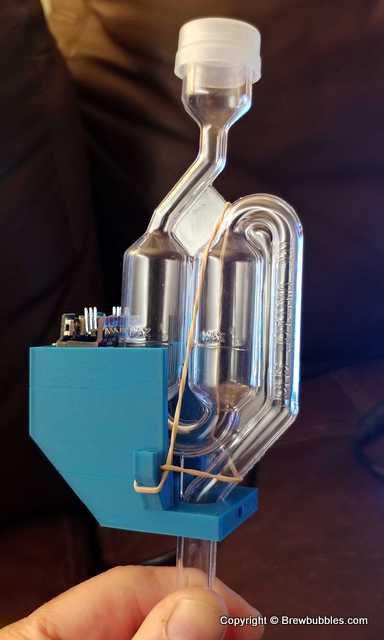- Joined
- Jul 9, 2019
- Messages
- 15
- Reaction score
- 14
- Points
- 3
I just did a Google search:

That seems to be pretty important to many homebrewers. Nobody agrees what's "right," and about all the Internet can do is help you pass the time in between trips to stare at the airlock.
Wouldn't it be great if someone made something to tell you when your airlock is bubbling? At the very least, it would cut down on your significant other asking you where you are going at 2:00 AM as you tiptoe out of the bedroom by the light of your cellphone. I mean, we're in a day and age where you can ask your television questions. You'd think someone would make something that could help. What if you don't have computers connected to your grain bin and antennas on your growlers?
Enter Brew Bubbles.

Brew Bubbles will happily count every bubble and report it to you on a web page served by its own web server. Not enough? Brew Bubbles optionally allows you to hook in a couple of very inexpensive and standard temperature probes to display the fermenter and room temperature.

Still not enough, you say?
Well, if you want to go crazy, you can connect Brew Bubbles to Brewer's Friend and integrate the readings with your recipe journal and see how it all graphs out. Already wired? Connect Brew Bubbles into BrewPi Remix or Fermentrack and amaze your friends!
Have I piqued your interest? Want to know how to get started? I'm glad you asked. The average garage handyman can build Brew Bubbles for around $10, and it takes all of an hour before you are up and running.
You can hit the website as a jumping-off point. I have prepared full documentation, or you can dive right into the repository if that's how you'd like to start.
The Homebrewtalk thread will serve for general support, true bugs should get logged to the issues in Github.
I really hope some of you will get some use out of this. I know there's a homebrew club up in Canada who have managed to find me already, and they are planning a club build. I'm pretty excited to see how it works out.
(Apologies to people who have read this already elsewhere. Also, and explaining the delay posting here, I do have permission from the folks who run this place to post this.)
That seems to be pretty important to many homebrewers. Nobody agrees what's "right," and about all the Internet can do is help you pass the time in between trips to stare at the airlock.
Wouldn't it be great if someone made something to tell you when your airlock is bubbling? At the very least, it would cut down on your significant other asking you where you are going at 2:00 AM as you tiptoe out of the bedroom by the light of your cellphone. I mean, we're in a day and age where you can ask your television questions. You'd think someone would make something that could help. What if you don't have computers connected to your grain bin and antennas on your growlers?
Enter Brew Bubbles.
Brew Bubbles will happily count every bubble and report it to you on a web page served by its own web server. Not enough? Brew Bubbles optionally allows you to hook in a couple of very inexpensive and standard temperature probes to display the fermenter and room temperature.
Still not enough, you say?
Well, if you want to go crazy, you can connect Brew Bubbles to Brewer's Friend and integrate the readings with your recipe journal and see how it all graphs out. Already wired? Connect Brew Bubbles into BrewPi Remix or Fermentrack and amaze your friends!
Have I piqued your interest? Want to know how to get started? I'm glad you asked. The average garage handyman can build Brew Bubbles for around $10, and it takes all of an hour before you are up and running.
You can hit the website as a jumping-off point. I have prepared full documentation, or you can dive right into the repository if that's how you'd like to start.
The Homebrewtalk thread will serve for general support, true bugs should get logged to the issues in Github.
I really hope some of you will get some use out of this. I know there's a homebrew club up in Canada who have managed to find me already, and they are planning a club build. I'm pretty excited to see how it works out.
(Apologies to people who have read this already elsewhere. Also, and explaining the delay posting here, I do have permission from the folks who run this place to post this.)










